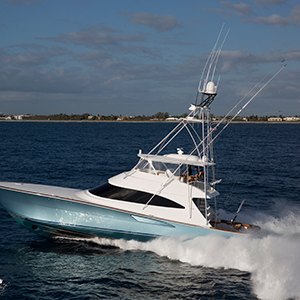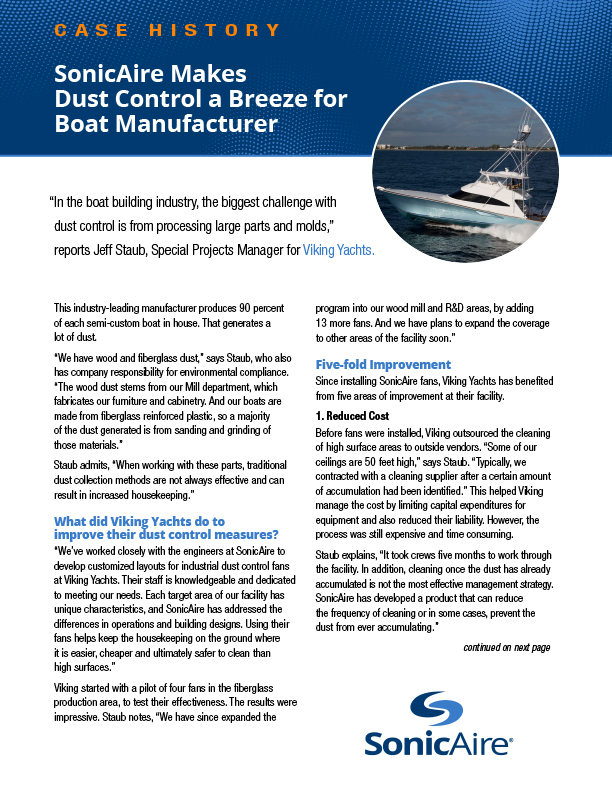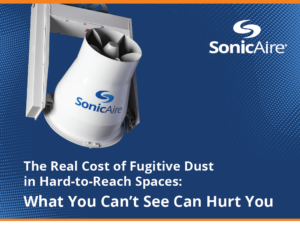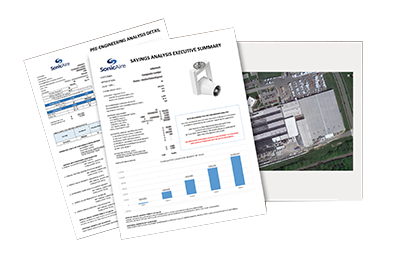 Viking Yachts
Viking Yachts
“In the boat building industry, the biggest challenge with dust control is from processing large parts and molds,” reports Jeff Staub, Special Projects Manager for Viking Yachts.
This industry-leading manufacturer produces 90 percent of each semi-custom boat in house. That generates a lot of dust.
“We have wood and fiberglass dust,” says Staub, who also has company responsibility for environmental compliance. “The wood dust stems from our Mill department, which fabricates our furniture and cabinetry. And our boats are made from fiberglass reinforced plastic, so a majority of the dust generated is from sanding and grinding of those materials.”
Staub admits, “When working with these parts, traditional dust collection methods are not always effective and can result in increased housekeeping.”
What did Viking Yachts do to improve their dust control measures?
“We’ve worked closely with the engineers at SonicAire to develop customized layouts for industrial dust control fans at Viking Yachts. Their staff is knowledgeable and dedicated to meeting our needs. Each target area of our facility has unique characteristics, and SonicAire has addressed the differences in operations and building designs. Using their fans helps keep the housekeeping on the ground where it is easier, cheaper and ultimately safer to clean than high surfaces.”

Since installing SonicAire fans, Viking Yachts has benefited from five areas of improvement at their facility.
- Reduced Cost
- Reduced Downtime
- Reduced Risk
- Increased Morale
- Increased Compliance
It didn’t take long for Viking Yachts to start reaping the benefits of SonicAire fans. Staub reports, “With SonicAire fans, it is immediately noticeable that high surfaces—where dust previously accumulated quickly—are clean.”
 Viking Yachts
Viking Yachts
“In the boat building industry, the biggest challenge with dust control is from processing large parts and molds,” reports Jeff Staub, Special Projects Manager for Viking Yachts.
This industry-leading manufacturer produces 90 percent of each semi-custom boat in house. That generates a lot of dust.
“We have wood and fiberglass dust,” says Staub, who also has company responsibility for environmental compliance. “The wood dust stems from our Mill department, which fabricates our furniture and cabinetry. And our boats are made from fiberglass reinforced plastic, so a majority of the dust generated is from sanding and grinding of those materials.”
Staub admits, “When working with these parts, traditional dust collection methods are not always effective and can result in increased housekeeping.”
What did Viking Yachts do to improve their dust control measures?
“We’ve worked closely with the engineers at SonicAire to develop customized layouts for industrial dust control fans at Viking Yachts. Their staff is knowledgeable and dedicated to meeting our needs. Each target area of our facility has unique characteristics, and SonicAire has addressed the differences in operations and building designs. Using their fans helps keep the housekeeping on the ground where it is easier, cheaper and ultimately safer to clean than high surfaces.”

Since installing SonicAire fans, Viking Yachts has benefited from five areas of improvement at their facility.
- Reduced Cost
- Reduced Downtime
- Reduced Risk
- Increased Morale
- Increased Compliance
It didn’t take long for Viking Yachts to start reaping the benefits of SonicAire fans. Staub reports, “With SonicAire fans, it is immediately noticeable that high surfaces—where dust previously accumulated quickly—are clean.”

GET YOUR FREE GUIDE:
The Real Cost of Fugitive Dust in Hard-to-Reach Spaces
What You Can’t See Can Hurt You
To help protect your workplace, we’ve compiled the following resource, The Real Cost of Fugitive Dust in Hard-to-Reach Spaces: What You Can’t See Can Hurt You. In it, we identify seven ways fugitive dust is likely impacting your facility and its profitability.
These costs go beyond housekeeping and explain why you should be preventing dust buildup to protect the bottom line, not just to stay in compliance.

